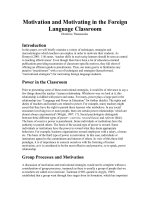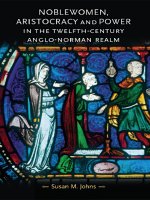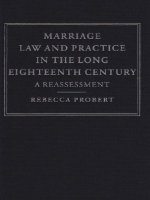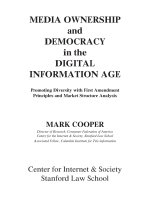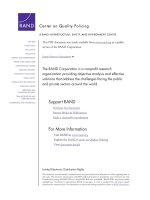Arts and Culture in the Metropolis pot
Bạn đang xem bản rút gọn của tài liệu. Xem và tải ngay bản đầy đủ của tài liệu tại đây (768.63 KB, 124 trang )
This document and trademark(s) contained herein are protected by law as indicated in a
notice appearing later in this work. This electronic representation of RAND intellectual
property is provided for non-commercial use only. Permission is required from RAND
to reproduce, or reuse in another form, any of our research documents.
Limited Electronic Distribution Rights
Visit RAND at www.rand.org
Explore RAND Research in the Arts
View document details
For More Information
Purchase this document
Browse Books & Publications
Make a charitable contribution
Support RAND
This PDF document was made available from www.rand.org as
a public service of the RAND Corporation.
6
Jump down to document
The RAND Corporation is a nonprofit research
organization providing objective analysis and
effective solutions that address the challenges facing
the public and private sectors around the world.
THE ARTS
CHILD POLICY
CIVIL JUSTICE
EDUCATION
ENERGY AND ENVIRONMENT
HEALTH AND HEALTH CARE
INTERNATIONAL AFFAIRS
NATIONAL SECURITY
POPULATION AND AGING
PUBLIC SAFETY
SCIENCE AND TECHNOLOGY
SUBSTANCE ABUSE
TERRORISM AND
HOMELAND SECURITY
TRANSPORTATION AND
INFRASTRUCTURE
WORKFORCE AND WORKPLACE
This product is part of the RAND Corporation monograph series. RAND
monographs present major research findings that address the challenges facing
the public and private sectors. All RAND monographs undergo rigorous peer
review to ensure high standards for research quality and objectivity.
Arts and
Culture
in the
Metropolis
Strategies for
Sustainability
Kevin F. McCarthy
Elizabeth Heneghan Ondaatje
Jennifer L. Novak
Sponsored by William Penn Foundation
and the Greater Philadelphia Cultural Alliance
The RAND Corporation is a nonprofit research organization providing
objective analysis and effective solutions that address the challenges
facing the public and private sectors around the world. RAND’s
publications do not necessarily reflect the opinions of its research clients
and sponsors.
R
®
is a registered trademark.
© Copyright 2007 RAND Corporation
All rights reserved. No part of this book may be reproduced in any
form by any electronic or mechanical means (including photocopying,
recording, or information storage and retrieval) without permission in
writing from RAND.
Published 2007 by the RAND Corporation
1776 Main Street, P.O. Box 2138, Santa Monica, CA 90407-2138
1200 South Hayes Street, Arlington, VA 22202-5050
4570 Fifth Avenue, Suite 600, Pittsburgh, PA 15213-2665
RAND URL: />To order RAND documents or to obtain additional information, contact
Distribution Services: Telephone: (310) 451-7002;
Fax: (310) 451-6915; Email:
Library of Congress Cataloging-in-Publication Data
McCarthy, Kevin F., 1945-
Arts and culture in the metropolis : strategies for sustainability /
Kevin F. McCarthy, Elizabeth Heneghan Ondaatje, Jennifer L. Novak.
p. cm.
Includes bibliographical references.
ISBN 978-0-8330-3890-6 (pbk. : alk. paper)
1. Arts—United States—Finance—Case studies. 2. Art patronage—United
States—Case studies. 3. Nonprofit organizations—United States—Case studies. 4.
Metropolitan areas—United States—Case studies. I. Ondaatje, Elizabeth Heneghan.
II. Novak, Jennifer L. III.Title.
NX711.U5M37 2007
700.973—dc22
2006101227
Cover design by Eileen Delson La Russo
This study was supported by a grant from William Penn Foundation
and the Greater Philadelphia Cultural Alliance and produced under the
auspices of RAND Education, a division of the RAND Corporation.
Preface
is study examines the size and structure of the arts sector and systems of support
in major metropolitan areas and identifies strategies for sustainability, with the aim of
providing policy recommendations to the city of Philadelphia.
e study was supported by a grant from William Penn Foundation and the
Greater Philadelphia Cultural Alliance. e sponsors selected the following cities for
examination: Baltimore, Boston, Charlotte, Chicago, Cleveland, Denver, Detroit,
Minneapolis, Phoenix, Pittsburgh, and, of course, Philadelphia.
is monograph should be of interest not only to Philadelphians but also to policy-
makers and arts leaders in these and other major metropolitan areas. Readers interested
in the roots of the current problems facing metropolitan arts sectors should focus on
Chapter Two. ose who are particularly interested in the methods we developed with
regard to applicability to other regions should look at Chapters ree and Four. ose
interested solely in Philadelphia should turn to Chapter Five.
e study was produced under the auspices of RAND Education, a division of
the RAND Corporation.
iii
Other RAND Books on the Arts
A New Framework for Building Participation in the Arts (2001)
Kevin F. McCarthy and Kimberly Jinnett
e Performing Arts in a New Era (2001)
Kevin F. McCarthy, Arthur Brooks, Julia Lowell, and Laura Zakaras
From Celluloid to Cyberspace: e Media Arts and the Changing
Arts World (2002)
Kevin F. McCarthy and Elizabeth H. Ondaatje
Gifts of the Muse: Reframing the Debate About the Benefits of the
Arts (2004)
Kevin F. McCarthy, Elizabeth H. Ondaatje, Laura Zakaras, and Arthur Brooks
Arts Education Partnerships: Lessons Learned from One School District’s
Experience (2004)
Melissa K. Rowe, Laura Werber Castaneda, Tessa Kaganoff, and Abby Robyn
State Arts Agencies, 1965–2003: Whose Interests to Serve? (2004)
Julia Lowell
A Portrait of the Visual Arts: Meeting the Challenges of a New Era (2005)
Kevin F. McCarthy, Elizabeth H. Ondaatje, Arthur Brooks, and András Szántó
e Arts and State Governments: At Arm’s Length or Arm in Arm? (2006)
Julia Lowell and Elizabeth H. Ondaatje
Contents
v
Preface iii
Figures
ix
Tables
xi
Summary
xiii
Acknowledgments
xix
CHAPTER ONE
Introduction 1
e Context
1
e Study
3
Objectives of the Monograph
3
Research Approach
4
e Organizational Infrastructure of the Local Arts Sector
4
e Structure of Local Support
4
e Larger Sociodemographic and Economic Context
5
Organization of the Monograph
6
CHAPTER TWO
e Roots of the Challenges Facing the Nonprofit Arts 7
Historical Patterns
7
e 1960s
8
e 1990s to the Present
11
Short- and Long-Term Issues
13
CHAPTER THREE
e Ecology of the Arts Sector 15
Introduction
15
Nonprofit Arts Organizations
17
Arts-Presenting Organizations
18
Financial Support
21
Community Context
24
vi Arts and Culture in the Metropolis: Strategies for Sustainability
Sociodemographics 24
Historical and Institutional Factors
26
Discussion
30
CHAPTER FOUR
Community Responses 33
Introduction
33
Organizational Arrangements
33
Structure
34
Division of Labor Among Agencies
38
Organizational Functions
40
Financing
41
Technical A ssista nce
45
Art Presentation
46
Promotion and Advocacy
47
Economic Development
49
Using the Framework As a Strategic Planning Tool
51
Comparing Communities by Service Levels
52
Ratings by Grant Levels
52
Ratings by Technical Assistance Function
54
Ratings by Arts Presentation and Public Art Functions
54
Ratings by Promotion and Advocacy Functions
54
Ratings by Economic Development Function
55
Support Systems and the Local Arts Ecology
56
CHAPTER FIVE
Philadelphia 59
Introduction
59
Philadelphia’s Arts Ecology
59
e Arts Infrastructure
59
Strengths and Weaknesses of the Arts Infrastructure
61
e Support Structure
64
Strengths and Weaknesses of the Support Structure
68
e Regional Environment
69
Strengths and Weaknesses of the Regional Context
73
reats, Opportunities, and Strategies to Deal with em
75
reats
75
Opportunities
78
Recommendations
81
e Longer Term
88
APPENDIX
List of Interviewees by City 91
Bibliography
97
Contents vii
Figures
ix
3.1. e Arts, Culture, and Entertainment Sector 16
3.2. Functions of Nonprofit Arts Organizations in the Eleven Metropolitan
Areas
18
3.3. Average Expenses by Type of Organization in the Eleven Metropolitan
Areas
20
3.4. Revenue Sources by Type of Organization for the Eleven Metropolitan
Areas
23
3.5. Arts-Presenting Organizations per 100,000 Residents
27
Tables
xi
S.1. Community Ratings by Function xv
3.1. Percentage of Organizations in the Eleven Metropolitan Areas by Focus
and Tax Status
16
3.2. Percentage of Arts-Presenting Organizations in the Eleven Metropolitan
Areas by Type
19
3.3. Revenue Sources in the Eleven Metropolitan Areas
22
3.4. Selected Sociodemographic and Economic Comparisons
25
4.1. Classification of Major Organizations
35
4.2. Characteristics of Cultural Affairs Offices
37
4.3. Characteristics of Single-Purpose Funding Agencies
37
4.4. Comparison of Service Levels by Function
41
4.5. Characteristics of Grant Programs
43
4.6. Community Ratings by Function
53
xiii
Summary
After three and a half decades of unprecedented growth, the nonprofit arts face an
environment that threatens to stunt that growth and raises the prospect of future con-
solidation. is situation poses severe challenges to the sustainability of local arts sec-
tors. Cognizant of these developments, William Penn Foundation and the Greater
Philadelphia Cultural Alliance asked RAND to examine the condition of Philadel-
phia’s arts sector and recommend actions to ensure its sustainability.
is study has three goals: (1) to identify the sources and characteristics of this
new environment, (2) to describe the ways local arts communities are responding to
new challenges, and (3) to analyze Philadelphia’s arts sector and recommend poten-
tial solutions to its sustainability problems. We drew upon a range of sources, both
quantitative (published data and reports) and qualitative (interviews, focus groups). In
the course of this analysis, we introduce two new approaches to examining local arts
sectors. e first, or ecological, approach focuses on the relationship among the three
components of local communities’ organizational ecology: their arts infrastructures;
the support systems upon which they depend; and the sociodemographic, economic,
and political environments in which they operate. e second is a framework we have
developed for describing and evaluating organizational mechanisms and operational
strategies adopted by local communities to support their arts sectors.
Starting in the mid-1960s and continuing until well into the 1990s, the arts sector
experienced a period of unprecedented expansion. Two factors played critical roles in
this development: the adoption of a common funding strategy and the proliferation
of new funding sources—government, foundation, corporate, and individual—that
allowed the implementation of that strategy.
By the mid-1990s, however, the feasibility of this approach was increasingly being
called into question in light of changes in funding practices. is situation raised
major challenges for local arts sectors: Arts organizations faced new competition for
funding and a new operating environment. In addition, they confronted a political
environment that required new funding strategies and new arguments for support.
xiv Arts and Culture in the Metropolis: Strategies for Sustainability
The Local Arts Ecology
e local arts ecology is made up of three components: the arts infrastructure, their
support structures, and the community contexts in which they operate. e arts infra-
structure consists of a small number of very large organizations (museums, perform-
ing arts centers, symphonies), a larger number of medium-sized organizations (mostly
theaters), and an even larger number of small organizations, all differing in the size
of their staffs and in the revenues they receive. e largest organizations constitute
only about 20 percent of all organizations but receive 60 percent of all the arts sector’s
revenues.
e organizations’ revenues come from a diverse mix of sources. About half are
from earnings (mostly from admissions); 40 percent from contributions and grants
(mostly from private rather than governmental sources and about as much from indi-
viduals as from business and foundation sources together); and the balance from other
sources, e.g., endowments and memberships. Revenue sources, however, differ by dis-
cipline and in terms of the availability and strength within specific communities.
e eleven communities in our analysis can be sorted into three categories: older
manufacturing centers that have faced major economic restructuring (Baltimore,
Cleveland, Detroit, Pittsburgh), mature regional centers with diversified economies
(Boston, Chicago, Denver, the Twin Cities), and newly emergent centers (Charlotte
and Phoenix). Philadelphia shares characteristics with the older manufacturing centers
and the mature regional centers. e growth patterns, socioeconomic profiles, and his-
tories of these communities differ; these differences help shape arts infrastructures and
the amount and sources of financial support that they provide to arts organizations.
Community Responses to New Challenges
Local communities have developed a variety of organizational arrangements and oper-
ational strategies to support their arts sectors. e organizational arrangements can be
categorized as to whether they are part of government or run as a private nonprofit,
whether they perform single or multiple functions, whether they view their primary
role as servicing the local arts sector or as facilitating the integration of the arts sector
with the wider community, and whether they limit their services to particular commu-
nities or serve the larger metropolitan community. All the communities in our analysis
either have established or are in the process of establishing organizations devoted spe-
cifically to support the arts and arts-related issues.
ese organizations provide a range of services to their arts sectors. We identify
five functional areas to characterize these services (financial support, technical assis-
tance, presentation of public art, promotion and advocacy, and economic develop-
Summary xv
ment). We also look at the types of organizations that supply services and to whom
those services are typically provided.
is framework can be used to describe and evaluate a community’s support
structure, its strengths and weaknesses, and the level of support offered to different
types of arts organizations (basic, moderate, or full). Table S.1 rates the eleven commu-
nities in our study in terms of the level of support given to the arts in each functional
area.
Table S.1
Community Ratings by Function
Function Basic Moderate Full
Grants Baltimore Chicago Charlotte
Boston Cleveland Denver
Detroit Twin Cities Pittsburgh
Philadelphia
Phoenix
Technical assistance Baltimore Boston Charlotte
Detroit Cleveland Chicago
Twin Cities Denver
Philadelphia
Phoenix
Pittsburgh
Presentation Cleveland Baltimore Boston
Detroit Charlotte Chicago
Pittsburgh Twin Cities Denver
Philadelphia
Phoenix
Promotion Detroit Baltimore Chicago
Twin Cities Boston Denver
Pittsburgh Cleveland Philadelphia
Charlotte
Phoenix
Economic development Cleveland Boston Chicago
Detroit Baltimore Charlotte
Philadelphia Phoenix Denver
Pittsburgh Twin Cities
xvi Arts and Culture in the Metropolis: Strategies for Sustainability
Philadelphia: Assessment and Recommendations
Philadelphia has a long cultural history—many of its major arts organizations were
founded before 1900—and its arts and culture sector has recently experienced signifi-
cant growth. Further evidence of the energy in the region’s arts sector can be found in
its growing attraction to both performing and visual artists. e strong subscription
base of the city’s orchestra and theatres, along with the success of various festivals,
shows that Philadelphia’s residents are active participants in the arts.
We use the analytical tools we have developed to describe the components of Phil-
adelphia’s arts ecology and its specific strengths and weaknesses. Based on this analysis,
we identify a series of threats and opportunities facing the arts sector and conclude
with a series of recommendations.
Threats
Despite the steady growth of the region’s arts infrastructure over the past decade, the
lack of growth both in the total population and in the number of college-educated
adults (the two principal determinants of current arts demand) could imperil that
growth and the region’s ability to support its arts sector.
e fragmentation of the region’s governmental and corporate leadership could
limit its ability to develop a clear vision and plan to address the arts sector’s sustainabil-
ity problems. Because the region is divided among three states and multiple munici-
palities, coordination of funding among states is highly unlikely, and much of the local
effort to increase governmental funding has focused on establishing a regional mecha-
nism to fund the arts within the five counties of southeastern Pennsylvania.
e diversity of population and communities within the Philadelphia region
could well increase the centrifugal forces in the region. is diversity is evident not just
between the city and the suburbs but within both of those areas, and the revitalization
of some neighborhoods contrasts sharply with the continued decline of others. Indeed,
Philadelphians often refer to “Philly disease”—the tendency of Philadelphia residents
to downplay its strengths as well as to identify with their local communities rather
than with the region as a whole.
In addition, despite the general collegiality within the arts community, the sharp
imbalance between the resources garnered by small and midsize institutions on the one
hand and large institutions on the other could encourage competition and divisions
within the arts community. And significant differences in the financial situations of
the region’s communities could impede efforts to deal with the sustainability problems
the region’s arts sector faces.
Finally, the long-term future of the region’s arts sector depends not simply on
its current situation but just as importantly on future demand. However, the absence of
arts education in the region’s public schools could pose future demand problems.
Summary xvii
Opportunities
Philadelphia’s current renaissance provides a real opportunity for its residents to take
pride in their city, to take stock of the region’s revitalization and what is needed to con-
tinue this process, and to recognize the important role the arts have played.
e upcoming mayoral election represents an opportunity for the arts commu-
nity and the city more generally to develop a plan for the sector’s sustainability. e
arts community should use the election campaign to raise the broader issue of the city’s
future and the strategies that are needed to build on the city’s current momentum. By
introducing this theme, the arts sector could underscore how far the city has come and
what factors (including the arts) have played a role in the city’s revitalization.
Private foundations are one of Philadelphia’s important assets and could play a vital
role in strengthening its arts sector. Because foundations are involved in a wide range
of civic projects in the city and the region, they can be a potent force for change.
Although the region’s governmental and corporate sectors have not stepped up to
the plate in supporting the arts in a major way, they have nonetheless expressed con-
siderable verbal support and have been generally positive toward the arts. But it is not
always clear that the city government and the corporate sector see a direct link between
Philadelphia’s revitalization and the arts. e arts community must challenge those
two sectors to back up their verbal support with more tangible efforts.
Many believe the region’s economic future depends on the growth of its “creative”
industries. Philadelphia has a solid foundation in such highly skilled industries as edu-
cation, medicine, biotechnology, and other creative industries. e region’s ability to
shift its economic base toward such industries will depend upon its ability to attract the
high-skilled workers these industries need. e arts sector and civic leaders more gener-
ally need to recognize and emphasize the important role the arts play in improving the
region’s quality of life and thus its ability to attract high-skilled workers.
Finally, despite Philadelphia’s location in the populous northeastern corridor and
its wealth of tourist attractions, employment in the region’s tourist industries has lagged
behind that of other regions.
xviii Arts and Culture in the Metropolis: Strategies for Sustainability
Recommendations
In light of our analysis, we make the following recommendations:
e evaluative framework explained in Chapter Four should be used to identify
gaps and opportunities in organizational structures and support functions. e
present study provides only a first cut at such an evaluation; a more complete
review of the region’s support structures is needed.
Philadelphia must develop a clear vision of where its arts sector should be headed
in the future and should spell out milestones to gauge its progress toward that
vision. e vision should be based on consultation with all elements of the arts
community, not just the major institutions.
e city should establish a new office of cultural affairs that serves as the prin-
cipal point of contact for artistic activities and includes a wider set of functions
than the previous office—tourism, film, and the integration of arts activities
with the community’s broader economic development activities.
Financial strains on the arts sector should be addressed from the point of view
of the sector as a whole, rather than on an exclusively organization-by-organiza-
tion basis. e traditional approach of individual fundraising by arts organiza-
tions raises the transaction costs for both organizations and funders. More col-
laborative approaches are needed.
Although short-term sustainability questions may be most pressing, arts orga-
nizations and the arts sector as a whole must be cognizant of building demand
for the arts and working toward that goal.
e arts sector is not likely to solve its sustainability problems without the active
support of the business and governmental sectors. Consequently, it needs to do
a better job of convincing the region’s civic leaders that the arts as a whole, not
just the major arts institutions, can promote Philadelphia’s broader interests and
its economic development goals.
1.
2.
3.
4.
5.
6.
xix
Acknowledgments
is work was sponsored by William Penn Foundation and the Greater Philadelphia
Cultural Alliance. We are particularly grateful for the encouragement and guidance of
Olive Mosier of William Penn Foundation, and Peggy Amsterdam and Julie Hawkins
of the Greater Philadelphia Cultural Alliance. We would also like to thank the arts
and civic leaders we interviewed in the eleven metropolitan regions for their invaluable
insights into their cities. ey are listed in the appendix.
e monograph also benefited from reviews by Andrew Taylor and Arthur Brooks,
whose constructive comments improved both its form and its substance.
Eileen Delson LaRusso’s art design will certainly help us with readers who judge
a book by its cover. Our production team—Peter Hoffman (managing editor), Miriam
Polon (editor), David Bolhuis (production manager), Kim Wohlenhaus (production
editor), and Christina Pitcher (proofreader)—shepherded the book through the publi-
cations process with alacrity, making improvements along the way. Finally, we thank
Isabel Sardou and Suzanne Benedict for their continued research support.
1
CHAPTER ONE
Introduction
The Context
America’s nonprofit arts flourished during the last half of the twentieth century. eir
success was evident in the unprecedented growth in the number and diversity of arts
organizations and their audiences. But the onset of the new century has brought a new
and more challenging environment. Fragmentation of leisure time and growing com-
petition from an expanding entertainment industry are posing obstacles to increased
participation in the arts. And managing resources has become more difficult in the
face of rising costs and greater competition for funding. Finally, the arts face a public
increasingly skeptical of government, reluctant to raise taxes, and inclined to demand
public accountability and empirical justification before expending public dollars.
is environment poses three major challenges to the health and vitality of the
nonprofit arts and their ability to sustain the growth of prior decades: First, the arts
need a new revenue strategy to replace the traditional nonprofit business model. Second,
they need to develop more collaborative approaches to cope with a more complex oper-
ating environment. ird, they need new arguments to generate more public support
in a new political environment.
Over four decades ago, Baumol and Bowen (1966) pointed out that the non-
profit arts face problems in relying exclusively on admissions for their revenues. e
labor-intensive nature of the arts, especially the performing arts, makes it difficult for
them to realize the benefits from gains in productivity that are characteristic of other
sectors of the economy. Although arts organizations are subject to the same upward
pressure on the price of labor, they are limited in their ability to raise prices to cover
those increasing costs. e result is a chronic gap between expenses and admissions
revenues.
at the nonprofit arts have grown dramatically despite this predicament is a
result of the success of the nonprofit funding strategy. Recognizing the structural gap
between admissions and expenses, this strategy posits that contributions from a vari-
ety of sources—government, business, foundations, and individuals—can fill the gap.
Further, it assumes that matching grants from one source can be used to leverage
funding from other sources. Finally, it assumes that this funding can be secured in
2 Arts and Culture in the Metropolis: Strategies for Sustainability
the form of general operating support, whose fungibility allows arts organizations to
spend their resources where they are most needed. Fueled by a dramatic expansion in
governmental, corporate, foundation, and individual funding that began in the 1960s,
this strategy has formed the cornerstone of arts organizations’ funding strategies for
the past several decades.
Recently, however, changes in funding practices have undermined the reliability
of these assumptions. e devolution of government arts funding from the federal to
the state level—and increasingly to the local level—has increased the volatility of that
funding. Corporations’ proclivity to tie their financial support to corporate market-
ing and branding goals has shifted that funding from general operating to project-
specific support. Pressure on foundations to promote specific social goals and respond
to requests in other social areas has caused many to prefer project-specific funding.
Individual contributions have also become more difficult to raise, for three reasons:
increasing competition among arts organizations, leisure patterns that make it more
difficult for organizations to build the kind of attachments to individuals that are cen-
tral to securing their support, and changing public expectations of what they deserve
in return for their support. In combination, these trends have increased the costs and
difficulties involved in securing contributions and have led arts organizations to explore
new fundraising strategies.
Traditionally, arts organizations have operated as though in a competitive zero-
sum environment in which one organization’s gain comes at the expense of another’s.
Lacking clear and distinct branding identities, they have guarded both their artistic
and organizational independence. ey have been reluctant to coordinate their fund-
raising and membership campaigns and programming efforts, and to share mailing
lists with other arts organizations. However, as marketing and fundraising costs have
risen, social pressures have increased to diversify audiences and serve the broader com-
munity. As their management and legal environment has become more complex, arts
organizations have been exploring collaboration to run their operations and secure
the operational expertise they need. is shift has been particularly true for the many
smaller arts organizations that lack the resources to hire outside experts.
Finally, the combination of rapid growth of the arts sector, cutbacks in local gov-
ernment funding, and public skepticism about government programs and higher taxes
has created a new political environment for the arts. Concomitantly, traditional argu-
ments in favor of more government support for the arts on the basis of their intrinsic
benefits have increasingly fallen on deaf ears. In response, the sector has adopted argu-
ments based on the arts’ broader instrumental—particularly economic—benefits and
their ability to support broader community goals.
1
e sector hopes that these argu-
ments will produce new funding sources—in particular, dedicated funding mecha-
nisms for governmental support.
1
e substance of this debate is discussed in McCarthy et al. (2004). See also American Assembly (1997).
Introduction 3
ese developments raise both short- and long-term issues for the nonprofit arts.
In the short term, the sector needs to find new sources of financial and political support
and to develop ways to operate more collaboratively. Over the longer term, it needs to
devise alternatives to the present nonprofit fundraising strategy or face inevitable con-
solidation.
2
Such consolidation would, in turn, raise questions about what constitutes
a healthy arts ecology and how it can be sustained.
The Study
In recognition of these challenges, William Penn Foundation and the Greater Phila-
delphia Cultural Alliance commissioned RAND to review the Philadelphia region’s
arts sector, identify the threats and opportunities it faces, and recommend strategies
to sustain the region’s cultural sector. During the past two decades, Philadelphia has
undergone a dramatic revitalization that observers attribute partly to the vitality of
its local arts sector. e continued health of Philadelphia’s nonprofit arts sector mat-
ters not just to the region’s arts community, but also to the city and the region more
generally.
e credit for the city’s artistic resurgence is often attributed to the strong sup-
port of the city’s former mayor, Edward Rendell. Mayor Rendell promoted the city’s
Office of Arts and Culture, pushed for the establishment of the Kimmel Center and
the Avenue of the Arts, and viewed the arts as a central element of his revitalization
strategy. Philadelphia’s current mayor, John Street, has emphasized a different set of
priorities and, faced with a tight budget, closed the Office of Arts and Culture and
challenged the arts sector to develop a new model for sustainability. As Mayor Street’s
term comes to a close and a new mayor is elected in 2007, the time is ripe to examine
the challenges the city’s arts sector faces and to develop new strategies to sustain it.
Objectives of the Monograph
is monograph first identifies the roots of the problems facing the nonprofit arts sector
in general and compares the organizational ecology of the arts in Philadelphia and ten
other metropolitan regions. It then analyzes the responses of these communities to
these challenges. Finally, it describes the strengths and weaknesses of Philadelphia’s
arts infrastructure, support systems, and regional context and the threats and oppor-
tunities they present. is description provides a basis for our recommendations.
2
A discussion of challenges to the existing nonprofit organizational model and possible alternatives has been
taking place recently not just at RAND, but elsewhere in the field. See Daly (2005), Ivey (2005), and McLennan
(2005), for three examples. Earlier examples of this discussion can be found in McDaniel and orn’s (1990) col-
lection of essays, notably orn’s prediction that the arts sector was entering a period of “cultural Darwinism.”
